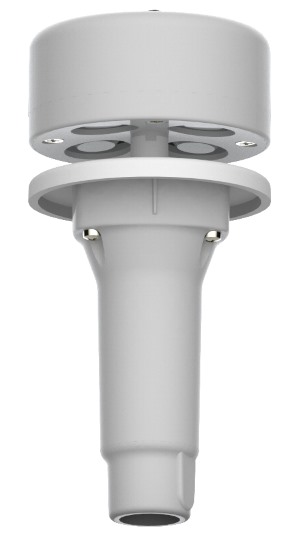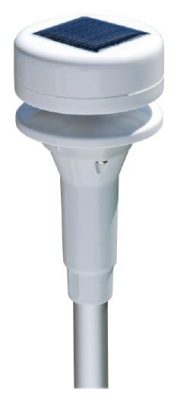Buy Now
Prodata is pleased to offer this Davis 6415 ultrasonic anemometer, a drop-in replacement for the standard 6410 anemometer on Davis VP2 stations. The 6415 unit represents the ultimate option for wind measurements in the VP2 class of weather station.

Ultrasonic anemometers have many benefits compared to the traditional mechanical anemometer such as the standard Davis 6410 model. Their key advantage is the lack of any moving parts (they operate by measuring the transit characteristics of ultrasound pulses across their sensor transducers), which provides several benefits:
- Ultrasonic anemometers are maintenance-free and have no moving parts to wear over time – there are of course no wind cups or wind vane and hence no mechanical bearings to deteriorate, causing increasing inaccuracy with age. Similarly there is no direction potentiometer to wear and no reed switches to become faulty;
- Resilience to harsh environments. As a result these anemometers are more suitable for use at eg coastal locations;
- Because they sense air movements directly rather than via mechanical parts (which cannot avoid responding with at least some lag), ultrasonic anemometers are able to be significantly more responsive and sensitive to wind gusts;
- A low start-up speed of 1mph (the actual DZP start-up speed is lower still at 0.3mph but VP2 stations have a minimum resolution of 1mph)
- Absence of a dead zone for direction around the 360° point;
- For locations where visual appearance or intrusion is important, the 6415 unit will always win out over a traditional anemometer. It is relatively unobtrusive and has a simple modernistic shape, which is also less likely to attract unwelcome attention;
All 6415 anemometers benefit from individual wind-tunnel testing prior to despatch from the factory and are supplied with a one-year RTB warranty. (An individual calibration certificate is available at extra cost.)
The DZP unit has excellent linearity over its wind speed measurement range of 1 – 40 m/s (approx 1 – 90 mph). Note though that this type of anemometer may be less suitable for locations with very cold winter (temperatures regularly below eg -20°C).
The 6415 anemometer consists of two parts – the sensor head itself (see image above and which has an overall height of about 120mm or 5″) and then a short (300mm) and slim (16mm) primary mounting pole (not shown). The recess on the bottom of the sensor head fits on to the primary pole, which can then be attached to a larger main mounting pole to locate the anemometer at the preferred measurement height. Mounting the unit is described in detail in the instruction manual to ensure that the unit is accurately aligned north-south as a direction reference.

The ultrasonic transducers can be seen in the underside of the upper element of the sensor head. The signal cable from the anemometer is identical to the standard VP2 6410 unit (now also including a 12m cable as standard) and terminates in an RJ11 connector exactly as for the 6410. The 6415 anemometer is therefore exactly plug-compatible with the 6410 and other than the different look and mounting arrangements it is simply plugged into the wind socket on the ISS circuit board exactly the same as with the 6410 anemometer. In addition to being electrically compatible, the data interface is also designed to mimic the standard 6410 anemometer exactly – the SIM circuit board will notice no difference at all to the 6410.
The DZP model is fully self-powered with a small solar panel on the upper face of the anemometer(see image left) and a rechargeable lithium LiFePO4 14500 battery in the stem of the unit, which can be replaced when it eventually reaches the end of its long life. The internal circuitry in the 6415 has a minimal current consumption and a new battery will power the unit for over 3 weeks in complete darkness.
Buy Now
